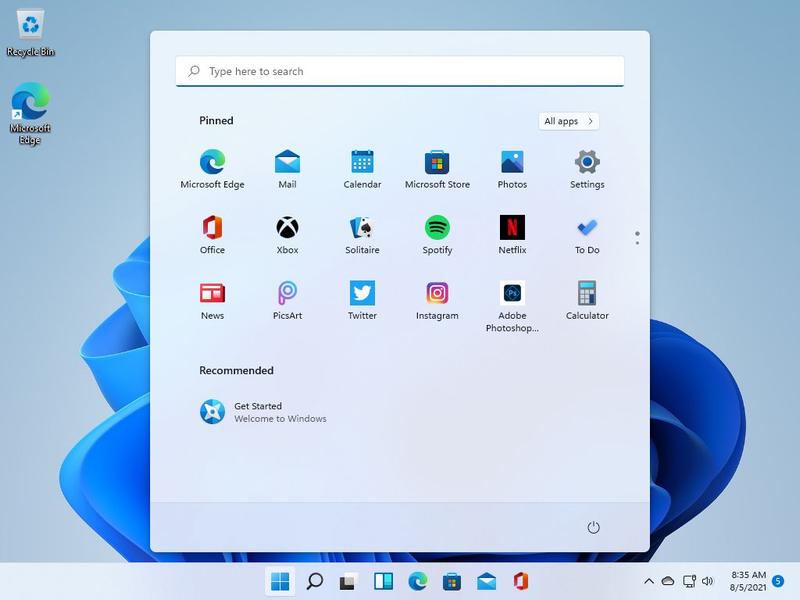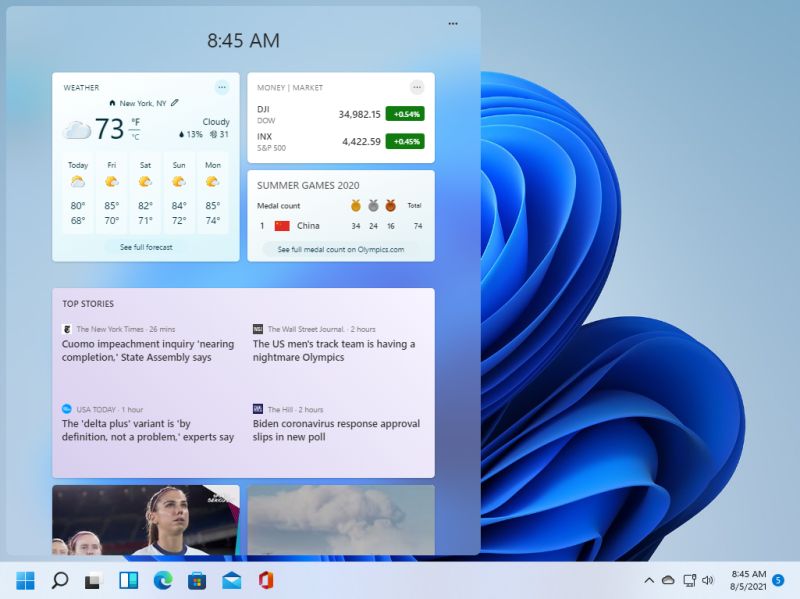Windows 11. It’s the latest Microsoft OS and its release is expected at the end of 2021 (Microsoft has annouced it will start the release on October the 5th). However, insider builds have been available for some time now. So as expected, we took a look at the new version to see what is what 😀
What’s New in Windows 11?
A lot of technical improvements have been made to Windows 11. But from a user perspective, the most noticeable features are the following.
1. Rounded Windows corners.
Yes, we are back to that. It’s funny to see that rounded corners are coming back in fashion. From rounded corners, everything changed to a flat and square design. Now things are curvy again with Windows 11. It is very personal, but it’s here whether you like it or not.
This is similar to what you would find on a Mac. Although this is a hot topic, it’s easy to move it to the left if you want. You just can’t have the Taskbar on the side of the screen anymore.
Perhaps what’s more useful is to focus on the contents of the Start menu. In windows 11, the focus is on quick access. So the Start menu now has a Pinned and Recommended section.

3. You can now load and run Android apps.
Android apps no longer need an emulator in Windows 11, as this latest Microsoft OS allows these apps to run natively in it. This will expand available applications for Windows 11. Apps will be installed through the Amazon Appstore.
4. Widgets are back.
Information on the screen is now displayed as a layover user interface. I rather think this is more suitable for touch devices than for desktop systems. But if you are keen on following information streams (e.g., news, weather, traffic, stocks, etc.) then it can be very useful.

5. Improved Windows Subsystem for Linux
The Windows subsystem for Limux (WSL) was already available for Windows 10. But the Windows 11 version is improved and extended. Installation is easier, and both sound and graphics are now also supported.
Installation can be done from an elevated command prompt. Apart from the latest Ubuntu version, other distributions can also be selected (you can even install multiple distributions next to each other).
From a practical perspective you do need to think hard if you need the Linux subsystem. Many Linux solutions are also availabel directly for Windows 11 itself. But if you are already using the existing WSL, then the new Windows 11 version will be a huge improvement.
And yes, there are many more new features and apps. Even audio has been re-designed to ‘sound better’.
In this case, Microsoft has deemed ‘better’ as softer and more pleasing to the ear. But a lot of the changes are targeted at the visual aspects, like fluent animations, better layout, and easy access.
Windows 11 – What’s Gone?
Yes, there are a lot of new things in Windows 11, but like with earlier Windows versions, some things are gone too.
Internet Explorer, Skype, Paint 3D, Snipping Tool, Cortana, and some other apps are gone. Oh, a lot of them are still there for you to use, but now they come disabled. Others though have been replaced by new apps.
Internet Explorer has been replaced by Edge, and for reasons of privacy and security, it is better to switch at some point to the latter if you are still using IE as your default browser.
Skype will be replaced by Chat Teams, even though Teams does not come pre-installed in Windows 11.
Some personalization settings are now device-specific. If you log onto a different PC with your personal Microsoft account, your personal settings are not used or carried over to the other device.
Tablet mode is gone. Windows 11 will itself adjust to the device and screen capabilities. This makes the tablet mode obsolete.
Windows 11 – What’s Required?
The hardware requirements for Windows 11 are outlined in detail by Microsoft.
A first assessment to see if your device will work with Windows 11 can be made by running the Microsoft PC Health Check app. This can be downloaded from the Microsoft Windows 11 site – soon. Microsoft took it offline due to some issues with the compatibility check 😉
Alternatives to the PC Health Check app are the Checkit app from WiseCleaner and WhyNotWin11 which is an open-source solution. Both will check your PC hardware and indicate the Windows 11 compatibility status for each category.
Apart from the minimal hardware requirements and compatibility, you will need a microphone, speakers, and a webcam for most communication features. A compatible webcam or fingerprint reader will be needed for biometric security.
One of the most critical requirements at the moment is the Trusted Platform Module (TPM). This is a piece of security hardware, which is used for encryption and authentication. For Windows 11 TPM, version 2.0 is required. (A lot of devices are still using TPM version 1.2.)
Perhaps Microsoft will enable Windows 11 for TPM 1.2 systems later, but at the moment this is not the case.
Hardware compatibility with Windows is partially ensured by the right device drivers for your PC hardware devices. Make sure you can benefit from optimal hardware performance and all supported features by installing the right drivers.
DriverFinder will scan your PC for all hardware present and find the correct, and most updated drivers for each device in your system.
Although hardware compatibility can be a limiting factor for many users, you will still need to decide if upgrading to Windows 11 is right for you. Considering how many users are still running Windows 7 and have not upgraded to Windows 10, I am sure quite a few users will not see the new features as a motivation to upgrade immediately.
But if you are about to replace your computer or tablet, then the Windows 11 upgrade might seem an obvious choice. Users of desktop PCs also have the option to upgrade components of their PC to make it compatible with Windows 11.
Update September 2021
As we now know, Microsoft will start the deployment of the Windows 11 release on October the 5th. Like with Windows 10, the update will be offered to Windows 10 users in a phased manner. So be patient if you are waiting for the update.
The Windows 11 update will be free for Windows 10 users.
A thing to consider before upgrading on older systems is the hardware compatibility. Although Microsoft seems to impose stricter hardware compatability enforcement in the Insider Program and Beta Channel, during actual rollout, it might be possible to install Windows 11 on older hardware.
There is no guarantee though that all future Windows 11 (security) updates will be compatible or supported on older platforms. So if you are a happy Windows 10 user on an older system, consider not upgrading. Especially since support for Windows 10 will be around October the 14th of 2025!
Update October 2021
Windows 11 should now be available to everyone. For Windows 10 users the release should come throug Windows Update.
If you are running an older system without TPM 2, you can still install Windows 11 in many cases. Rather than including all details about how to do that, we refer to this link for instructions and details.
Note: when you try to upgrade a system that is not meeting the Windows 11 system requirements, make sure to get installation files from a reputable source. Hackers are preying on people trying to install Windows 11 on systems that do not meet the system requirement by offering installation files that are infected with malware!
- DYMO LabelWriter 450 Driver Software - April 14, 2025
- DriverFinder Version 5.0.0 - March 4, 2024
- Vulnerable Windows Drivers Could Allow Device Takeover - November 7, 2023

